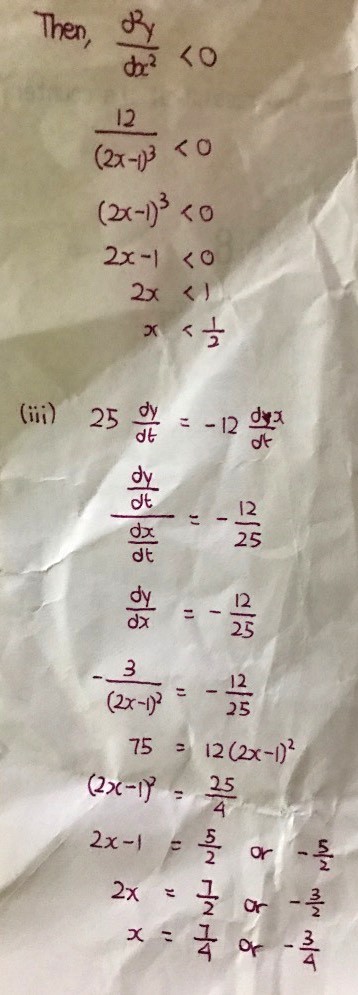Eric Nicholas K's answer to MM's Secondary 4 A Maths Singapore question.
done
{{ upvoteCount }} Upvotes
clear
{{ downvoteCount * -1 }} Downvotes
The remaining portion of the second part and the third part
You still need help with the other question?
You still need help with the other question?
Date Posted:
3 years ago
Second derivative guves the value of x . Is it correct sir?
Sir the previous question part (b)
The current question (ii)
In this case for part ii we will have to find the range of values of x satisfying the condition.
There is a difference between "the curve is decreasing" and "the gradient is decreasing". Big difference.
When the curve is decreasing, its gradient function, represented by dy/dx, is negative. This is because the curve has to go down.
When the gradient is decreasing, however, ITS gradient function, which is the derivative of dy/dx, or in other words d2y/dx2, is negative. This is because its graph is heading downwards.
So, in other words, for the gradient to be decreasing, we need to find the range of values of x such that d2y/dx2 is less than zero.
d2y/dx2 simplifies to 12 / (2x - 1)^3.
Since d2y/dx2 < 0,
12 / (2x - 1)^3 < 0
The numerator 12 is positive, so for the fraction to be negative, the denominator must be negative.
(2x - 1)^3 < 0
Taking cube roots do not affect the inequality sign.
2x - 1 < 0
x < 1/2
which is what you will get for part ii.
For the other question, I will do later - today and tmr are long days for me.
There is a difference between "the curve is decreasing" and "the gradient is decreasing". Big difference.
When the curve is decreasing, its gradient function, represented by dy/dx, is negative. This is because the curve has to go down.
When the gradient is decreasing, however, ITS gradient function, which is the derivative of dy/dx, or in other words d2y/dx2, is negative. This is because its graph is heading downwards.
So, in other words, for the gradient to be decreasing, we need to find the range of values of x such that d2y/dx2 is less than zero.
d2y/dx2 simplifies to 12 / (2x - 1)^3.
Since d2y/dx2 < 0,
12 / (2x - 1)^3 < 0
The numerator 12 is positive, so for the fraction to be negative, the denominator must be negative.
(2x - 1)^3 < 0
Taking cube roots do not affect the inequality sign.
2x - 1 < 0
x < 1/2
which is what you will get for part ii.
For the other question, I will do later - today and tmr are long days for me.
Thank you sir . Understood
Attempting the other question now



